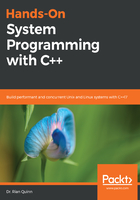
The anatomy of a system call
For the purposes of this section, we will focus our examples on the Intel x86 architecture, although these examples apply to most other CPU architectures.
The original x86 architecture leveraged interrupts to provide system call ABIs. The APIs provided by the operating system would program specific registers on the CPU, and make a call to the operating system using an interrupt.
For example, using BIOS, an application could read data from a hard disk using int 0x13 with the following register layout:
- AH = 2
- AL: Sectors to read
- CH: Cylinder
- CL: Sector
- DH: Head
- DL: Drive
- ES:BX: Buffer address
The application author would use the read() API command to read this data, while under the hood, read() would perform the system call using the preceding ABI. When int 0x13 executed, the application would be paused by the hardware, and the operating system (in this case, BIOS) would execute on behalf of the application to read data from the disk and return the result in the buffer provided by the application.
Once complete, BIOS would execute iret (interrupt return) to return to the application, which would then have the data read from disk waiting in its buffer to be used.
With this approach, the application doesn't need to know how to physically interface with the hard disk on that specific computer in order to read data; a task that is meant to be handled by the operating system and its device drivers.
The application doesn't have to worry about other applications that may be executing either. It can simply leverage the provided API (or ABI, depending on the operating system), and the rest of the gory details are handled by the operating system.
In other words, system calls provide a clean delineation between applications, to help the user accomplish specific tasks, and to help the operating system whose job it is to manage these applications and the hardware resources they require.
Interrupts are, however, slow. The hardware makes no assumptions about how the operating system is written, or how the applications the operating system is executing are written or organized. For this reason, interrupts must save the CPU state before the interrupt handler is executed, and restore this state when the iret command is executed, leading to poor performance.
As will be shown, applications make a lot of system calls when attempting to perform their job, and this poor performance became a bottleneck on x86 architectures (as well as other CPU architectures).
To solve this issue, modern versions of Intel x86 CPU provided fast system call instructions. These instructions were designed specifically to address the performance bottleneck of interrupt-driven system calls. However, they require coordination between the CPU, the operating system, and the applications executing on that operating system to reduce overhead.
Specifically, the operating system must structure the memory layout of itself and the applications it's running in a specific way, dictated by the CPU. By predefining the memory layout of the operating system and its associated applications, the CPU no longer needs to save and restore as much CPU state when performing a system call, reducing overhead. How this is accomplished is different depending on whether you're executing on an Intel or AMD x86 CPU.
The most important thing to understand with respect to how a system call is performed is that a system call is not cheap. Even with fast system call support, a system call has to perform a lot of work. In the case of reading data from a hard disk via the read() API, the CPU register state must be set up and a system call instruction must be executed. CPU control is handed off to the operating system to read data from the disk.
Since more than one application might be executing, and attempting to read data from the disk at the same time, the operating system might have to pause the application so that it can service another.
Once the operating system is ready to service the application, it must first figure out what data the application is attempting to read, which ultimately determines which physical device it needs to work with. In our example, this is a hard disk, but on a POSIX-compliant system it could be any type of block device.
Next, the operating system must leverage one of its device drivers to read data from this disk. This takes time, as the operating system has to physically program the hard disk to ask for data from a specific location, over a hardware bus that almost certainly is not executing at the same speed as the CPU itself.
Once the hard disk finally provides the operating system with the requested data, the operating system can provide this information back to the application and return control, restoring the CPU state to the application. All of this insanity is obscured by a single call to read().
For this reason, system calls should be executed sparingly, and only when absolutely needed, to prevent the poor performance of the resulting application.
It should be noted that this type of optimization requires a deep understanding of the APIs the application leverages, as higher-level APIs make their own system calls on the API's behalf. For example, allocating memory, as will be discussed later, is another type of system call.
For example, look at the difference between using an std::array{} or a std::vector{} command. std::vector{} supports resizing of the array being managed under the hood, which requires memory allocation. This can not only lead to memory fragmentation (a topic that will be discussed later on in this book), but also poor performance, as the memory allocation might have to ask the operating system for more system RAM.